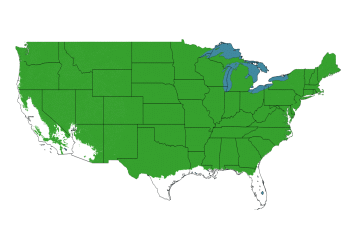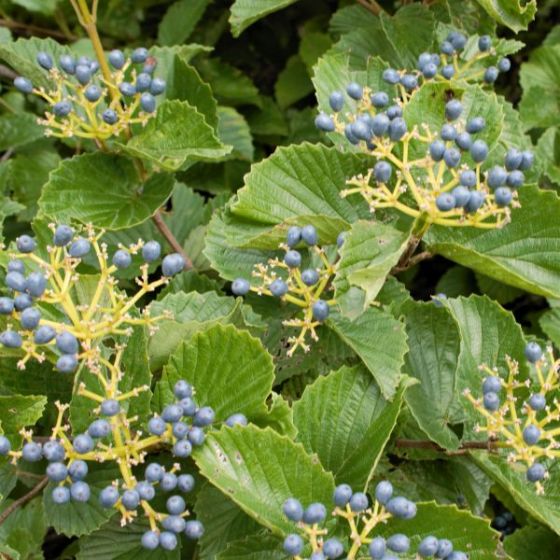✖
Ornamental Habitat Native Arrowwood Viburnum
- Lustrous Dark Green Foliage in Summer
- Excellent Yellow and Reddish Purple Fall Color
- Flat Topped Creamy White Flowers Bring Butterflies
- Blue-Black Berries Feed Birds
- Fast Growing Screening or Hedging Plant in Sun or Part Shade
- Deer Resistant, Unless They Are Really Hungry
- Native to North America
- Host Food for Native Butterflies
- Straight Shoots Were Used by Native Americans as Arrow Shafts
If you are a fan of the magnificent North American outdoors, you'll want to consider adding native Arrowwood Viburnum (Viburnum dentatum) to your landscape. Plant a few as a hedge along the house or in a naturalized area for spring interest.
This fast-growing, deciduous shrub has showy spring flowers that bring butterflies by the thousands. It's also a host plant for several caterpillars, including the fantastic Hummingbird Moth.
You'll love how the flowers appear like small bouquets of tiny white blossoms. The raised stamens give them a delightfully fuzzy appearance that will tempt you to reach out and touch. Spring flowers in flat-topped clusters give way to bluish purple fruit drupes that will be a feast for your wildlife.
If not eaten, the fruit may persist through winter for added interest. Many types of birds not only eat the Arrowwood Viburnum's fruit, but also use the shrub for shelter and even nesting.
Fall color goes through a myriad of colors of yellow, orange, red, and purple. What a wonderful, large growing shrub that has flowers in spring, fruit in summer, and phenomenal fall color! With a multi-season of interest, this hardy plant delivers a showy presence in the landscape.
If you're interested in creating an encouraging habitat for wildlife, the Arrowwood Viburnum will be a useful addition to your yard. Its foliage is an important food source for the Azure butterfly and several species of moth.
With stick straight new shoots, the Native Americans used to cut their arrow shafts from this pretty shrub. Why not cut some for your indoor flower arrangements? The quilted, finely-toothed leaves are so attractive. They'll add a dimensional texture to any bouquet.
Arrowwood grows well in full sun to partial shade. It is adaptable to most soil types but prefers moist to wet soils. This native variety is also resistant to bores.
It's a hardy plant that shouldn't give you any trouble, and a good choice for almost any landscape. It's really just a handsome, healthy plant you'll be proud to own.Order yours today!
How to Use Arrowwood Viburnum in the Landscape
Arrowwood makes an excellent, fast-growing backdrop for mixed shrub borders and native landscapes. It develops into a rounded shrub with lustrous leaves. The multiple seasons of interest and incredible fall color make this a winning selection.
This persistent, long-lived shrub is used for privacy, to easily screen out unsightly views, and as an excellent hedge plant. Arrowwood also makes a great backdrop to a native planting and can be used in Rain Gardens.
Try this variety in larger screening projects. We recommend that you grow your Arrowwood hedges informally for the best look. Don't shear them, or you'll lose the flowers and fruit.
To create a solid screen, plant Arrowwood 2 or 3 feet apart, measuring from the center of one to the center of the next. If you have patience, expand that distance out to 4 feet apart.
They can be used as snow fencing or including in larger shelterbelts and windbreaks. This is because Arrowwood plants are broad and dense all the way down to the ground
However you use these shrubs, you'll be pleased to know that you are creating a valuable habitat for birds, butterflies and other beneficial pollinators. Be sure to tell your garden visitors about the benefits. Maybe you'll spark some interest and create a trend in the neighborhood!
#ProPlantTips for Care
Arrowwood is native over a wide range and tolerates many soil types and is not only drought tolerant but very adapts well to most situations.
Give them a moderate amount of regular water, especially when young. After the roots are established in your native soil, the plants are tolerant of periodic drought. Water them in extended dry periods.
These are best renewal pruned in late winter. Cut out the thickest stems out to the ground and leave the nice, young, thin stems. In this way, you'll help your plant produce the best blooms and fruit. To reduce the size, wait until the bloom is done before your tip prune.
You'll love the lush, full appearance and the play of butterflies all blooming season. Just wait until you see the flash of reds and yellows with the arrival of autumn. Order your Arrowwood Viburnum today and get started!
| Botanical Name | Viburnum dentatum |
|---|---|
| Mature Height | 8 - 10 feet |
| Mature Spread | 8 - 10 feet |
| Soil Type | Widely Adaptable |
| Moisture | Moderate |
| Sun Exposure | Full Sun, Partial Shade |
| Growth Rate | Fast |
| Bloom Period | Late Spring |
| Flower Color | White |
| Foliage Color | Green |
| Fall Color | Red, Purple, Yellow |
| Pollinator Required | No |
| Pollinator Friendly | Yes |
| Growing Zone Range | 3-8 |

Write Your Own Review

